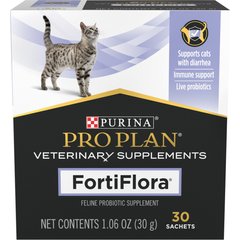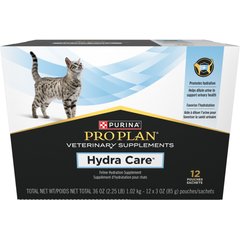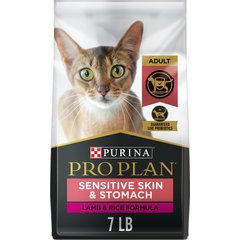6 Easy Ways to Improve Your Cat’s Skin
PetMD Editorial
6 Easy Ways to Improve Your Cat’s Skin
By Paula Fitzsimmons
The condition of your cat’s skin and coat is about more than just appearances–it’s also a reflection of your feline’s health. Building a strong foundation that includes sound nutrition, effective flea prevention, and good grooming is essential to good skin, according to vet experts.
Skin problems in cats are often a sign that something significant is going on, says Dr. Jennifer Larsen, associate professor of clinical nutrition at the University of California-Davis School of Veterinary Medicine. If your cat is pulling out her hair or forcefully scratching her face and shoulders, for example, it could be due to parasites or allergies, she says.
Diagnosis and treatment of skin conditions should always be left to your vet, but there are some simple and natural things you can do to improve your cat’s skin.
Feed a Diet With Key Nutrients
Feeding your cat a balanced and complete diet is essential to overall health and well-being, but several nutrients play a prominent role in skin and hair vitality. Both omega-6 and omega-3 fatty acids are essential for good skin, explains Dr. Sherry Sanderson, associate professor at The University of Georgia College of Veterinary Medicine.
She says cats require two types of omega-6 fatty acids: Linoleic acid, which is found in vegetable oils, and arachidonic acid, often sourced from animal fats. Omega-6 fatty acids, “help maintain the health and integrity of epithelial tissues, such as skin.”
Alpha-linolenic acid (ALA) and eicosapentaenoic acid (EPA) are two omega-3 fatty acids that also aid in skin and coat health. Sanderson says that ALAs, sourced from foods like flaxseeds, help maintain the skin’s water permeability barrier. Most commonly found in certain fish oils, EPAs are important for their anti-inflammatory properties and role in normal cell membrane fluidity.
Because nutrition is so crucial to your cat’s skin and health, it’s essential not to skimp on quality. But how do you know if what you’re feeding your cat is up to standard? Elizabeth Goodale, DVM, a veterinary dermatologist at UC-Davis, says, “I typically recommend owners look for a statement that the diet they are feeding has either been feed-trial tested or formulated to meet the Association of American Feed Control Officials’ (AAFCO) nutritional guidelines.”
6 Easy Ways to Improve Your Cat’s Skin
 Feliway Optimum Enhanced Calming 30 Day Diffuser for CatsRated 3.9 out of 5 stars1590Reviews$29.99Chewy Price
Feliway Optimum Enhanced Calming 30 Day Diffuser for CatsRated 3.9 out of 5 stars1590Reviews$29.99Chewy Price Purina Pro Plan Veterinary Diets FortiFlora Powder Probiotic Digestive Supplement for Cats, 30 countRated 4.7 out of 5 stars5622Reviews$30.99Chewy Price
Purina Pro Plan Veterinary Diets FortiFlora Powder Probiotic Digestive Supplement for Cats, 30 countRated 4.7 out of 5 stars5622Reviews$30.99Chewy Price Purina Pro Plan Veterinary Diets Hydra Care Liver Flavored Liquid Supplement for Cats, 3-oz pouch, case of 12Rated 4.4 out of 5 stars2622Reviews$14.99Chewy Price
Purina Pro Plan Veterinary Diets Hydra Care Liver Flavored Liquid Supplement for Cats, 3-oz pouch, case of 12Rated 4.4 out of 5 stars2622Reviews$14.99Chewy Price Purina Pro Plan Adult Sensitive Skin & Stomach Lamb & Rice Formula Dry Cat Food, 7-lb bagRated 4.6 out of 5 stars2242Reviews$28.08Chewy Price
Purina Pro Plan Adult Sensitive Skin & Stomach Lamb & Rice Formula Dry Cat Food, 7-lb bagRated 4.6 out of 5 stars2242Reviews$28.08Chewy Price
Invest in Good Flea Prevention
Most cats brought to Goodale’s clinic are there because they have itchy skin. In an attempt to find relief, a cat may overzealously scratch or lick, which Goodale says can result in the development of wounds and partial baldness.
A common source of itching, according to Goodale, are fleas and flea allergies. “I would definitely recommend that all cats be kept on a regular monthly flea preventative, because fleas and flea allergies are a very common source of skin issues in cats.”
Goodale recommends veterinary-prescribed preventives, and warns against using medicines formulated for dogs. “Placing a dog’s flea prevention product on a cat is dangerous because cats are very sensitive to some of the drugs used in dog flea preventives,” she says. Goodale also suggests staying away from at-home remedies for flea control, since they can be ineffective and dangerous to cats.
Practice Good Grooming Habits
Eliciting purrs and strengthening the bond with your cat aren’t the only reasons to regularly brush and comb her. According to Goodale, brushing and combing can help prevent mats from developing. She says mats can cause discomfort for cats, as well as cause skin infections and hair loss if the matting is severe.
Brushing can also help promote shine by redistributing the coat’s natural oils.
Consider investing in a high quality grooming tool specifically designed for cats. Robert Schick, DVM, a veterinary dermatologist with BluePearl Veterinary Partners, which operates emergency and specialty veterinary hospitals throughout the United States, says de-shedders are good, because they remove excess hairs.
Establish a grooming regimen early in the cat’s life, Larsen advises. “It should be introduced during kittenhood so that brushing and similar handling are not only tolerated but enjoyed.”
Bathe Your Cat for Certain Skin Conditions
There is rarely a need to shampoo a cat’s hair, Sanderson says, especially since most cats self groom. Plus, “cats in general are not very cooperative when it comes to bathing, and it can be extremely stressful for both cat and owner. I would only do this as a last resort.”
But, if your cat is itchy or just plain dirty, Goodale says you can try giving him a bath. “The important thing is to use a shampoo labeled for cats and to make sure that you rinse it out well. I would also avoid any shampoos containing tea tree oil,” she says. Tea tree oil is known to be toxic to cats when used at high concentrations.
Schick recommends bathing for some of his feline patients, especially those with allergic diseases. If you find bathing too difficult or stressful, he says, “it may be helpful to wipe the cat down with a cool, damp rag as well. This helps remove airborne allergens.” Examples of airborne allergens include mold spores, dust mites, and pollen from weeds and grasses.
Your veterinarian might also recommend a medicated shampoo to help treat other types of feline skin problems. In these cases, always follow your veterinarian’s instructions regarding when and how to wash your cat.
Watch Your Cat’s Stress Level
If your cat’s licking becomes excessive, it may result in hair loss, also known as alopecia. When your vet has determined that the cause of your cat’s excessive licking has a psychological rather than physical origin, the condition is diagnosed as psychogenic alopecia. Sanderson says cats may engage in this type of compulsive behavior to relieve stress. While cats with psychogenic alopecia rarely over-groom themselves to the point of skin damage, the condition is a sign that they are experiencing significant levels of anxiety or tension. Owners should be concerned, not just because of the hair loss, but because stress increases the risk of other, more serious conditions in cats, including idiopathic feline lower urinary tract disease.
For this reason, “minimizing stress, such as having adequate vertical space where a cat can retreat and feel safe, can be helpful,” Sanderson says. She also suggests interacting with your cat as much as possible, which can include petting and playing with toys together. A food ball that dispenses treats can be a good diversion when your cat is alone. Cats with severe psychogenic alopecia can also benefit from treatment with anxiety-relieving medications.